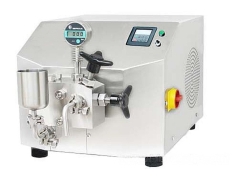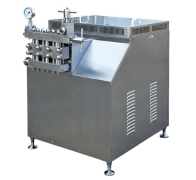Success Technic Industries
27, Jalan 6/2, Taman
Industries Selesa Jaya,
Off Jalan Balakong,
43000 Seri Kembangan,
Selangor, Malaysia.
Malaysia
Industries Selesa Jaya,
Off Jalan Balakong,
43000 Seri Kembangan,
Selangor, Malaysia.
Malaysia
+603-8961 4628 (Office)
+6012-322 2577 (Mr Wong)
+6013-957 9148 (Kenny)
+6012-322 2577 (Mr Wong)
+6013-957 9148 (Kenny)
dynaken

 |
+6013-957 9148 |
 |
kenny968178 |
|
|
dynaken |
 |
successte wong |
 |
ppgg26 |
 |
2074517608 |
 |
my1007542573 |
UL750-4000D 4000W 10-300 liter Ultrasonic Homogenizer
| Previous | 1 / 16 | Next |
UL750 Industrial ultrasonic devices are powerful, efficient and reliable. They are built to operate continuously at high load in industrial environments. With up to 16kW per device, Success Technic is the leading ultrasonics supplier for industrial liquid processes. Ultrasonic liquid processing at industrial level requires industrial ultrasonic equipment, because the power requirement rises with the volume or flow to be processed. Laboratory devices – although capable of handling up to one ton per day – are not sufficient for production processes. Success Technic is the leading ultrasonics supplier for industrial liquid processing applications, such as, the dispersing & milling of pigments in paints or inks, formulation of high performance coatings with nanomaterials, manufacturing of biodiesel or the pasteurization of food or beverage.
Technical Parameter and Order Code

Application in coating formulation
Ultrasound in Coating Formulation Various components, such as pigments, fillers, chemical additives, crosslinkers and rheology modifiers go into coating and paint formulations. Ultrasound is an effective means for the dispersion and emulsifying, deagglomeration and milling of such components in coatings. Ultrasound is used in the formulation of coatings for: emulsification of polymers in aqueous systems dispersing and fine milling of pigments size reduction of nanomaterials in high-performance coatings Coatings fall into two broad categories: water-borne and solvent based resins and coatings. Each type has its own challenges. Directions calling for VOC reduction and high solvent prices stimulate growth in water-borne resin coating technologies. The use of ultrasonication can enhance the performance of such eco-friendly systems. Ultrasound can help formulators of architectural, industrial, automotive and wood coatings to enhance the coating characteristics, such as color strength, scratch, crack and UV resistance or electrical conductivity. Some of these coating characteristics are achieved by the inclusion of nano-size materials, e.g. metal oxides (TiO2, Silica, Ceria, ZnO, …). Ultrasound does further help in the defoaming (entrapped bubbles) and degassing (dissolved gas) of highly viscous products. As ultrasonic dispersing technology can be used on lab, bench-top and production level, allowing for throughput rates over 10 tons/hour it is being applied in the R&D stage and in the commercial production. Process results can be scaled up easily (linear). Hielscher ultrasonic devices are very energy efficient. The devices convert approx. 80 to 90% of the electrical input power into mechanical activity in the liquid. This leads to substantially lower processing costs. Below, you can read about the use of ultrasound in the emulsification of polymers in aqueous systems, the dispersing and fine milling of pigments, and the size reduction of nanomaterials. Emulsion Polymerization Traditional coating formulations use basic polymer chemistry. The change to water-based coating technology has an impact on raw material selection, properties and formulation methodologies. In conventional emulsion polymerization, e.g. for waterborne coatings, the particles are built from the center to their surface. Kinetic factors influence particle homogeneity and morphology. Ultrasonic processing can be used in two ways generate polymer emulsions. Top-Down: Emulsifying/dispersing of larger polymer particles to generate smaller particles by size reduction Bottom-Up: Use of ultrasound before or during particle polymerization Nanoparticulate Polymers in Miniemulsions The polymerization of particles in miniemulsions allows for the manufacturing of dispersed polymer particles with good control over particle size. The synthesis of nanoparticulate polymer particles in miniemulsions ("nanoreactors"), as presented by K. Landfester is method for the formation of polymeric nanoparticles. This approach uses the high number of small nanocompartments (disperse phase) in an emulsion as nanoreactors. In these, the particles are synthesized in a highly parallel fashion in the individual, confined droplets. In her paper (The Generation on Nanoparticles in Miniemulsions) Landfester presents the polymerization in nanoreactors in high perfection for the generation of highly identical particles of almost uniform size. The image above shows particles obtained by polyaddition in miniemulsions. Small droplets generated by the application of high shear (ultrasonication) and stabilized by stabilizing agents (emulsifiers), can be hardened by subsequent polymerization or by temperature decrease in the case of low-temperature-melting materials. As ultrasonication can produce very small droplets of almost uniform size in batch and production process, it allows for a good control over the final particle size. For the polymerization of nanoparticles, hydrophilic monomers can be emulsified into an organic phase, and hydrophobic monomers in water. When reducing the particle size, the total particle surface area increases at the same time. The picture to the left shows the correlation between particle size and surface area in case of spherical particles (Click for larger view!). Therefore, the amount of surfactant needed to stabilize the emulsion increases almost linearly with the total particle surface area. The type and amount of surfactant influences the droplet size. Droplets of 30 to 200nm can be obtained using anionic or cationic surfactants. Pigments in Coatings Organic and inorganic pigments are an important component of coating formulations. In order to maximize the pigment performance good control over the particle size is needed. When adding pigment powder to waterborne, solventborne or epoxy systems, the individual pigment particles tend to form large agglomerates. High-shear mechanisms, such as rotor-stator mixers or agitator bead mills are conventionally being used to break such agglomerates and to grind down the individual pigment particles. Ultrasonication in an extremely effective alternative for this step in the manufacturing of coatings. The picture to the right (Click for larger view!) show the impact of sonication on the size of a pearl luster pigment. The ultrasound grinds the individual pigment particles by high-speed inter-particle collision. The prominent advantage of Ultrasonic processing over high speed mixers, media mills is the more consistent processing of all particles. This reduces the problem of "tailing". As it can be seen on the picture, the distribution curves are almost shifted to the left. Generally, ultrasonication does produce extremely narrow particle size distribution (pigment milling curves). This improves the overall quality of the pigment dispersions, as larger particles typically interfere with processing capability, gloss, resistance and optical appearance. Since the particle milling and grinding is based on inter-particle collision as a result of ultrasonic cavitation, ultrasonic reactors can handle fairly high solid concentrations (e.g. master batches) and still produce good size reduction effects. The table below shows pictures of the wet-milling of TiO2 (Click at the pictures for a larger view!). before sonication after sonication TiO2 from ball mill spray dried TiO2 The picture to right (Click for larger view!) shows the particle size distribution curves for the deagglomeration of Degussa anatase titanium dioxide by ultrasonication. The narrow shape of the curve after sonication is a typical feature of ultrasonic processing. Nanosize Materials in High Performance Coatings Nanotechnology is an emerging technology making its way into many industries. Nanomaterials and nanocomposites are being used in coating formulations, e.g. to enhance abrasion and scratch resistance or UV-stability. The biggest challenge for the application in coatings is the retention of transparency, clarity, and gloss. Therefore, the nanoparticles have be very small to avoid interference with the visible spectrum of the light. For many applications, this is substantially lower than 100nm. The wet grinding of high-performance components to nanometer range becomes a crucial step in the formulation of nanoengineered coatings. Any particles that interfere with the visible light, cause haze and loss in transparency. Therefore, very narrow size distributions are required. Ultrasonication is a very effective means for the fine milling of solids. Ultrasonic cavitation in liquids causes high speed inter-particle collisions. Different from conventional bead mills and pebble mills, the particles themselves are comminuting each other, rendering milling media unnecessary.





















